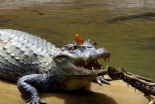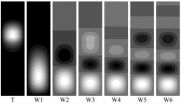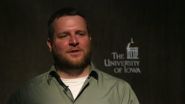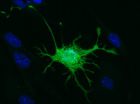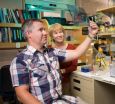(Press-News.org) The butterfly (Dryas iulia) and the bee (Centris sp.) were most likely seeking scarce minerals and an extra boost of protein. On a beautiful December day in 2013, they found the precious nutrients in the tears of a spectacled caiman (Caiman crocodilus), relaxing on the banks of the Río Puerto Viejo in northeastern Costa Rica.
A boat carrying students, photographers, and aquatic ecologist Carlos de la Rosa was passing slowing and quietly by, and caught the moment on film. They watched [and photographed] in barely suppressed excitement for a quarter of an hour while the caiman basked placidly and the insects fluttered about the corners of its eyes.
De la Rosa reported the encounter in a peer-reviewed letter in the May 2014 issue of the Ecological Society of America's journal Frontiers in Ecology and the Environment.
"It was one of those natural history moments that you long to see up close," said de la Rosa, the director of the La Selva Biological Station for the Organization for Tropical Field Studies in San Pedro, Costa Rica. "But then the question becomes, what's going on in here? Why are these insects tapping into this resource?"
Though bountiful in the ocean, salt is often a rare and valuable resource on land, especially for vegetarians. It is not uncommon to see butterflies sipping mineral-laden water from mud puddles. When minerals are rare in the soil, animals sometimes gather salt and other rare minerals and proteins from sweat, tears, urine, and even blood.
De la Rosa had seen butterflies and moths in the Amazon feeding on the tears of turtles and a few caimans. Tear-drinking "lachryphagous" behavior in bees had only recently been observed by biologists. He remembered a 2012 report of a solitary bee sipping the tears of a yellow-spotted river turtle in Ecuador's Yasuní National Park. But how common is this behavior?
Back at the field station, he did a little research. He was surprised to find more evidence of tear-drinking than he expected in the collective online record of wilderness enthusiasts, casual tourists, professional photographers, and scientists. He now thinks the phenomenon may not be as rare as biologists had assumed—just hard to witness.
"I did a Google search for images and I found out that it is quite common! A lot of people have recorded butterflies, and some bees, doing this," said de la Rosa.
A search of the scientific literature produced a detailed study of bees drinking human tears in Thailand, as well as the remembered October 2012 "Trails and Tribulations" story about the Ecuadorian bee and the river turtle by Olivier Dangles and Jérôme Casas in ESA's Frontiers.
This experience reminds us that the world still has many surprises for ecologists, de la Rosa said. There so much still to be studied. De la Rosa is a specialist in the biology of non-biting midges, and a natural historian, with his eyes always open to new discoveries. Scientists at La Selva have discovered hundreds of species of aquatic insects that are still unnamed and undescribed.
"I have over 450 undescribed species from Costa Rica in my laboratory. If I did nothing for the rest of my life but collaborate with taxonomists and try to describe those, I would never get done," he said.
De la Rosa's job as director of La Selva Biological Station brings him an unusual number of serendipitous encounters with wildlife. He lives on site in the lowland rainforest, and he never needs an alarm clock. Howler monkeys wake him every morning.
"I learned I have to carry a camera with me 24/7, because you never know what you're going to find when you're walking to the office or the dining hall," he said. One day, he spied a new species of dragonfly on his way to breakfast. It had emerged from its larval form in the small pool of water caught in the cupped leaves of a bromeliad plant. He did a double-take. Dragonflies don't live on bromeliads. Or do they?
"Those are the kinds of things that, you know, you don't plan for them, you can't plan for them," de la Rosa said. There was only one known species of dragonfly in the world that lives in bromeliads. Now there will be two. "You just keep your eyes open and have curiosity, and when you see something that doesn't seem to fit, dig."
INFORMATION:
Carlos L de la Rosa (2014) Additional observations of lachryphagous butterflies and bees. Frontiers in Ecology and the Environment 12(4): 210
The Ecological Society of America is the world's largest community of professional ecologists and a trusted source of ecological knowledge. ESA is committed to advancing the understanding of life on Earth. The 10,000 member Society publishes five journals, convenes an annual scientific conference, and broadly shares ecological information through policy and media outreach and education initiatives. Visit the ESA website at http://www.esa.org.
La Selva Biological Station and its parent institution, the Organization for Tropical Studies, manage a 1,600-hecter lowland rainforest preserve connected to large conservation areas in northeastern Costa Rica. The station is nearly 60 years old, and maintains some of the longest running tropical ecology datasets. Each year, it hosts 250 to 340 researchers from over 100 institutions, and many specialized courses in biology.
Crocodile tears please thirsty butterflies and bees
2014-05-01
ELSE PRESS RELEASES FROM THIS DATE:
Competition of the multiple Gortler modes in hypersonic boundary layer flows
2014-05-01
The present study illustrates, for the hypersonic flows, through the local and marching analysis, the crossover of the mode W and the mode T at O(1) wavenumber and large Görtler number regime. In fact, it is at this wavenumber regime that the instability is most likely to occur. The two approaches are expected to deliver similar results and the marching analysis helps to express the details of the crossover and confirm the result of the local analysis.
In fact the study of Görtler instability goes back to the date of the 1940s. Since Görtler's pioneering investigation ...
Vitamin D deficiency linked to aggressive prostate cancer
2014-05-01
CHICAGO --- African-American and European-American men at high risk of prostate cancer have greater odds of being diagnosed with an aggressive form of the disease if they have a vitamin D deficiency, according to a new study from Northwestern Medicine® and the University of Illinois at Chicago (UIC).
Results of the study will be published May 1 in Clinical Cancer Research, a journal of the American Association for Cancer Research.
"Vitamin D deficiency could be a biomarker of advanced prostate tumor progression in large segments of the general population," said Adam ...
Extreme sleep durations may affect brain health in later life
2014-05-01
BOSTON, MA – A new research study led by Brigham and Women's Hospital (BWH) published in The Journal of the American Geriatrics Society in May, shows an association between midlife and later life sleeping habits with memory; and links extreme sleep durations to worse memory in later life. The study suggests that extreme changes in sleep duration from middle age to older age may also worsen memory function.
"Sleep Duration In Midlife and Later Life In Relation to Cognition: The Nurses' Health Study," led by Elizabeth Devore, ScD, instructor in medicine in the Channing ...
New UT Arlington research could improve pharmaceuticals testing
2014-05-01
A UT Arlington chemistry professor, renowned for his work in the area of chemical separations, is leading an effort to find a more accurate way to measure water content in pharmaceuticals – a major quality issue for drug manufacturers.
Daniel W. Armstrong, UT Arlington's Robert A. Welch Chair in Chemistry, says the new technique could be 100 times more sensitive than one of the most popular current methods.
"The analysis for water in many consumer products, including drugs, is one of the most required tests done in the world," said Armstrong. "Current methods have many ...
Playing pool with carbon atoms
2014-04-30
A University of Arizona-led team of physicists has discovered how to change the crystal structure of graphene, more commonly known as pencil lead, with an electric field, an important step toward the possible use of graphene in microprocessors that would be smaller and faster than current, silicon-based technology.
Graphene consists of extremely thin sheets of graphite: when writing with a pencil, graphene sheets slough off the pencil's graphite core and stick to the page. If placed under a high-powered electron microscope, graphene reveals its sheet-like structure ...
Ground breaking technique offers DNA 'Sat Nav' direct to your ancestor's home 1,000 years ago
2014-04-30
Tracing where your DNA was formed over 1,000 years ago is now possible due to a revolutionary technique developed by a team of international scientists led by experts from the University of Sheffield.
The ground breaking Geographic Population Structure (GPS) tool, created by Dr Eran Elhaik from the University of Sheffield's Department of Animal and Plant Sciences and Dr Tatiana Tatarinova from the University of Southern California, works similarly to a satellite navigation system as it helps you to find your way home, but not the one you currently live in – but rather ...
Cutting cancer to pieces: New research on bleomycin
2014-04-30
A variety of cancers are treated with the anti-tumor agent bleomycin, though its disease-fighting properties remain poorly understood.
In a new study, lead author Basab Roy—a researcher at Arizona State University's Biodesign Institute—describes bleomycin's ability to cut through double-stranded DNA in cancerous cells, like a pair of scissors. Such DNA cleavage often leads to cell death in particular types of cancer cells.
The paper is co-authored by professor Sidney Hecht, director of Biodesign's Center for BioEnergetics. The study presents, for the first time, alternative ...
Infertile women want more support
2014-04-30
VIDEO:
University of Iowa Communication Studies researchers Keli Steuber and Andrew High talk about infertility.
Click here for more information.
Many women coping with infertility count on relatives or close friends for encouragement and assistance. But according to research at the University of Iowa, when it comes to support, women may not be receiving enough—or even the right kind.
"Infertility is a more prevalent issue than people realize. It affects one in six couples, ...
Stem cells from teeth can make brain-like cells
2014-04-30
University of Adelaide researchers have discovered that stem cells taken from teeth can grow to resemble brain cells, suggesting they could one day be used in the brain as a therapy for stroke.
In the University's Centre for Stem Cell Research, laboratory studies have shown that stem cells from teeth can develop and form complex networks of brain-like cells. Although these cells haven't developed into fully fledged neurons, researchers believe it's just a matter of time and the right conditions for it to happen.
"Stem cells from teeth have great potential to grow into ...
Salk Institute study identifies novel regulator of key gene expression in cancer
2014-04-30
LA JOLLA—Scientists at the Salk Institute for Biological Studies have identified a key genetic switch linked to the development, progression and outcome of cancer, a finding that may lead to new targets for cancer therapies.
The switch, a string of nucleotides dubbed a long non-coding RNA (lncRNA), does not code for proteins like regular RNA. Instead, the scientists found, this particular lncRNA acts as an on/off switch for a key gene whose excessive activity is tied to inflammation and cancer, COX-2.
The COX-2 gene mediates inflammation, which in most cases helps our ...
